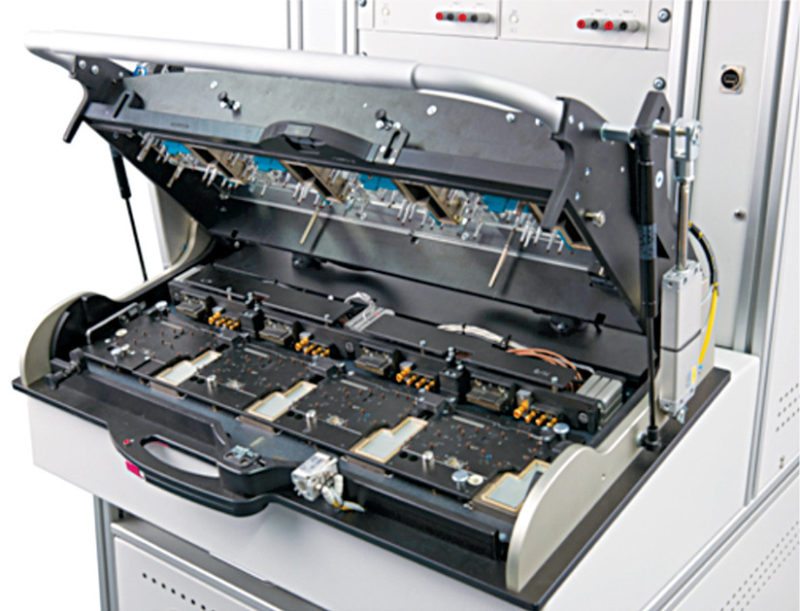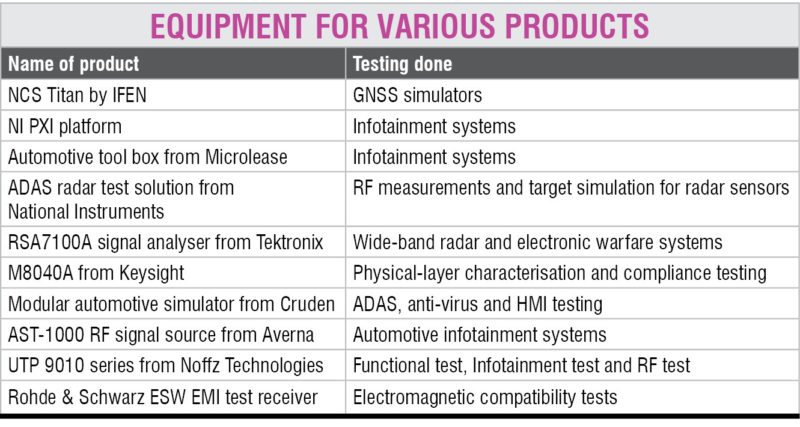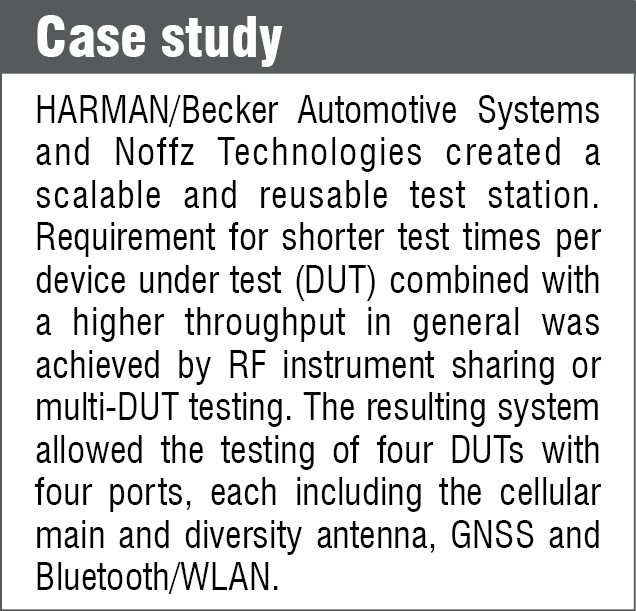Vehicles, system components and machines are becoming increasingly autonomous and network with each other via wireless technologies. Touchscreen based controls, remote diagnostics, vehicle status and control are being implemented using controller area network bus for interconnects.
However, with the best of vehicles, all issues cannot be solved in the vehicle itself. Puneet Gupta, chief technology officer, Brillio Technologies, categorises the testing of modules into a couple of categories. He says, “First, we have the immediate threats that need to be handled at the user end. Then, there are some problems that can be solved in the Cloud.”
Immediate threats cause physical harm
Electronic stability control (ESC) is the involvement of electronics in braking systems. Such systems help drivers avoid crashes by reducing the occurance of skidding or losing control. Mehul Garg, embedded design engineer, Padmini VNA Mechatronics Pvt Ltd, explains, “On detecting a loss of control, a number of intelligent sensors automatically apply brakes to the relevant wheel.” ESC becomes active when a driver loses control of the car. It uses computer-controlled technology to apply individual brakes and help bring the car safely back on track, without the danger of fishtailing.

Under-steering and over-steering may be fun while playing games, but these can be disastrous in real life. Garg highlights the reasons to be wary of over-steering.
Over-steering, for example, on slippery roads, could result in fishtailing and cause serious injury to multiple vehicles. These kinds of systems cannot be left to be processed in the Cloud. Immediate action has to be taken, that would require a support system after sensing a discourse.
Besides the dangers that require immediate attention, there are several threats over the long term. Infotainment, for example, might not allow a Bluetooth connection due to some issues. This can be diagnosed over the Cloud, resulting in in-vehicle processing focused on saving lives. So once we know the threats, what are the areas to test for?
Areas for focus in testing
Even with the most basic of vehicles, acceleration and deceleration form the crux of driving. These systems need to be tested properly with as low a chance of error as possible. Then, the vehicle should be checked to see if it follows the rules and guidelines of proper driving including acknowledging traffic lights and lane-driving.
Any autonomous system at its heart employs a battery for operation. Nisarg Nirmalkumar, senior software developer, RA Consulting GmbH, adds, “The battery needs to be tested as well.”
Connected devices prone to hacks.
Wireless connectivity features like Wi-Fi, Bluetooth and 3G or LTE present possibilities of remote attacks. Keyless entry and ignition do not require the attacker to have physical access to the vehicle.
The number of wireless standards available has created the need for similar equipment to generate signals for testing those modules. “If we have a wireless infotainment system, we need to test it for wireless standardisations as well,” says Kalyan Verma, vice president, products, TUV Rheinland India. Test solutions would typically require maximum radio frequency (RF) testing performance with flexible chip control through several software layers.

With autonomous vehicles making rapid paces in recent times, advanced driver-assistance systems (ADASes) have been on the rise. ADASes today are about taking control of the vehicle away from the driver. Sensor technologies like radars, ultrasounds, cameras and dedicated short range communication for vehicle to everything (DSRC for V2X) present attack surfaces that could seriously impact the safety of the vehicle. Radar or DSRC signals can also be easily spoofed, confusing ADAS algorithms into steering in the wrong direction, or driving into an obstacle.
 With smartphones coming into play, another issue of security arises with software applications. A Trojan Horse computer program can easily gain entry into the infotainment system through a paired Bluetooth device or Wi-Fi connection. Media content played via USB and CD are issues along similar lines.
With smartphones coming into play, another issue of security arises with software applications. A Trojan Horse computer program can easily gain entry into the infotainment system through a paired Bluetooth device or Wi-Fi connection. Media content played via USB and CD are issues along similar lines.
Vulnerabilities in the media code can be exploited to plant malicious software in the infotainment system. Weak information technology security further adds to the problems.
Increasing number of modules in the infotainment system
Modular testing systems have been a big help in this regard. PXI platform from National Instruments is one solution for modular hardware platforms that can be configured with key software tools.
With traditional approach to automotive infotainment RF tuner testing, test engineers need multiple instruments to generate different broadcast and navigational standards. Modular systems allow testing of multiple parameters using the same instruments.
For example, the same signal vector generator can be used to simulate GPS and digital video broadcast by simply reprogramming PXI platform.
“Human-machine interface/user interface (HMI/UI), infotainment features or functionalities, common tests and stress tests are the four major perspectives with current infotainment platform validation,” says Deepak Hebbur, co-founder, Skillfinity.
He adds, “The features are tested as per requirements and functionality.” Common tests are for quality, response time and power consumption. Stress tests include voltage curves, electromagnetic compatibility and heat emissions.Traditional RF tuner testing required multiple instruments to generate different broadcast standards. Multiple instruments were required to generate multiple carrier signals to test the critical functionalities in the infotainment systems, including channel search, alternate frequency selection, emergency and traffic announcements, among others.
Multiple high-definition acquisitions and synchronisation is required to detect issues arising from such systems. Surround sound, encryption schemes and full-HD video in latest infotainment systems have made multimedia test applications increasingly more complex.
One example of automotive test that requires an integrated, high-performance solution is ensuring the synchronisation of multiple screens for an infotainment system. Hebbur says, “Validations are also done to confirm the robustness of the UI where you try multiple button presses in a crazy sequence to check if the system handles all the presses gracefully.”
Testing electronics
All electronics in a vehicle must do their tasks properly. Verma says, “Different modules are supposed to work as an environment and, hence, call for testing at various stages.”
“For proper autonomous vehicles, we work on individual modules, testing these against the required parameters.
After module testing, the environment as a whole is tested,” adds Gupta. “Lab car is used to simulate the vehicle’s running environments, and parameters are measured to check its proper functioning,” explains Nirmalkumar.

“We simulate the running conditions in a lab and then capture the readings,” explains Verma.
Testing these modules, however, raises the question of quantity. Lexus LIT IS, for example, is one-of-a-kind vehicle with about 42,000 LEDs. These LEDs in 2017 model of Lexus LIT IS are programmed to change colour in response to human gestures and music. People’s fascination aside, testing the electronics is already a humongous task with such devices.
Automated testing is the way to go.
Testing of automotive systems has been growing in size and complexity over the past few years. A modern luxury car may very well have up to 100 engine control units. At such high numbers, regular testing just does not cut it, and calls for appropriate test platforms to address the need for automation, automotive specific I/O and flexibility.
Automation has become increasingly valuable to automotive applications due to the complexity involved in testing whole infotainment systems. Testing an infotainment system without automation may take weeks and many man-hours. An automated infotainment test system, however, does it much faster. Test time can now be reduced to a day or two at most. Test procedures can be run in parallel for multiple software stacks for highly-aggressive development.
Safety and security are important
Current systems employ RF based protocols for detection and authentication of owners to unlock doors and start the engine. These protocols allow remote eavesdropping and have done so in the past. Due to the large code size and complexity, these extend the range of remote attacks to many tens of metres, or even kilometres.
The megamos crypto transponder, commonly found in keys and key fobs for wireless entry systems, is supposed to stop an engine from starting without the transponder being near the vehicle. However, fake frequency modulation transmitters broadcasting radio data system traffic message channel (RDS-TMC) information, adversely influencing the navigation system in cars, have been found to attack.
Tyre-pressure-monitoring systems also employ RF protocols to send pressure sensor information from within the tyre to an engine control unit in the vehicle. These protocols have been sniffed and spoofed to fool the engine control unit into reporting a false tyre-pressure warning to the driver. An attack on the system at the wrong time could have safety consequences in case the driver is distracted or alarmed.
The need for smart(er) cars
Smartcars still lack reliable means of communication. With vehicles, even a minuscule chance of error could lead to major disasters. Human involvement in driving provides for swift action being taken in real time.
Autonomous vehicles leave a lot of open areas for question. A smart vehicle runs on algorithms, which is to create a parallel to the human mind. However, unlike the human mind, any number of algorithm or security-breach problems can lead to disaster. Tesla or Google cars’ accidents are prime examples. Proper testing can help root out problem areas, so that the next Uber you take is much safer.
Saurabh Durgapal is working as technology journalist at EFY







